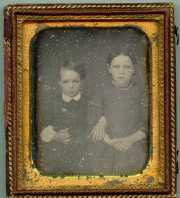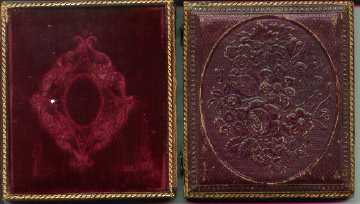Sign up for the Family Tree Newsletter Plus, you’ll receive our 10 Essential Genealogy Research Forms PDF as a special thank you!
Get Your Free Genealogy Forms
"*" indicates required fields
 |
 |
| Daguerrotype | Case (front and back) |
“Maybe you could remind people to cultivate memories from old people,” suggested Dave and Mary Hughes, who were hoping for identification of this double portrait of two young children. It belonged to Dave’s grandmother, Jane Marie Batterson, born in 1888. In 1970, she was unable to identify either of the children, and now Dave wishes his grandmother had learned the names of the children in this beautiful portrait. Since she was the youngest member of her family, that information may have been given to her older siblings but not to her. Now it is up to the Hughes to try to find where these children fit into the family tree.
This is not the first time I’ve featured a daguerreotype in this column (see New Zealand Mystery), but in this example both the picture and case are shown. Details in both can establish a time frame. (In most photo identifications, it is the accumulated evidence—not an individual clue—that establishes a date.)
A daguerreotype is a shiny piece of metal that needs to be held at a particular angle in order to view the reversed image. It consists of the image, a mat, a cover glass, a preserver (a thin strip of metal that holds all the pieces together) and the case. Cases were made out of various substances including paper, leather and gutta percha (a mixture of guncotton and ether). In many collections, the cases no longer exist due to breakage or because they were used for other purposes. The cases contain clues to when the pictures were taken. The shape and style of the mat over the picture can place the image within a time frame as can the design on the exterior of the case. In this instance, the outside design, known as a flower medallion, appears in American Miniature Case Art (A.S. Barnes, out of print) by Floyd and Marian Rinhart. The name of the casemaker is unknown, but the Rinharts dated the design on this leather case to circa 1854. That means we can rule out any dates prior to 1854.
Let’s see if the clothing helps us date the image. When first looking at the daguerreotype, you can see the child on the right is a girl and the one on the left a boy. Since boys and girls often wore similar clothing when young it helps to look at their hair. Girls wore their hair parted in the center and boys on the side. The young girl, probably around 7 years old is wearing a long-waisted dress with braided trim around the upper sleeve. A double strand of coral beads surrounds her neck. The inner strand is barely visible tucked into her neckline. The boy with his arm linked through his sister’s has on a tunic with a shirt worn underneath. Both outfits date from the mid-1850s to early 1860s. It is difficult to assign a more specific date because they are seated and the girl’s dress is not completely visible.
However, since the date of the case is circa 1854 and the children’s clothing is from the same period, I think this portrait was taken at mid-decade rather than later. Case designs changed quite often, so if this picture had been taken by 1860 or later, it probably would have been placed in a more ornate mat and case.
I love the intense expression on the girl’s face while her brother is focusing on something in the distance. She is concentrating on sitting still for several minutes while the picture is taken. Her brother obviously failed to sit quietly and that’s why he is a little blurred. Photographers used special braces and clamps to help people keep steady for the length of time it took for the exposure. While it’s not visible in this picture, the children may be sitting in special photographer’s chair with clamp to hold their head still. The slightest movement could blur the picture.
For a daguerreotype taken in the mid-19th century, it is in fairly good condition except for spots on the mat and the broken case. The spots on the image itself are not dust but caused by deterioration of the cover glass. Daguerreotypes look sturdy because they are metal but in fact the image is very fragile. While you might be tempted to clean the surface of the picture, don’t do it. You can permanently wipe away all evidence of the image. If a daguerreotype in your collection is need of conservation, contact a professional conservator. The American Institute for the Conservation of Historic and Artistic Works at aic.stanford.edu offers a free referral service.
As a young child, Dave Hughes listened to his grandmother’s stories of her childhood, but didn’t ask enough questions. For this reason he suggests that we take time to talk with older family members before it is too late. It’s a great idea to have a list of questions to help provide focus and a tape recorder handy to record the memories. I agree with Dave. Show your photographs to family members so that you can preserve your photographic heritage. Start today!
Find out how to submit your own picture for possible analysis by Maureen Taylor. E-mail her at mtaylor@taylorandstrong.com.
ADVERTISEMENT

